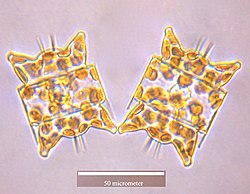This article relies largely or entirely on a single source .(November 2019) |
| Biddulphiophycidae | |
|---|---|
 | |
| Odontella aurita | |
| Scientific classification | |
| Domain: | Eukaryota |
| Clade: | Sar |
| Clade: | Stramenopiles |
| Phylum: | Ochrophyta |
| Clade: | Diatomeae |
| Clade: | Biddulphiophyceae |
| Clade: | Biddulphiophycidae |
| Families | |
Biddulphiophycidae or Biddulphiineae is a grouping of Centrales. [1] In some taxonomic schemes Centrales or Centric diatoms are named Coscinodiscophyceae and may have different naming of suborders and families.